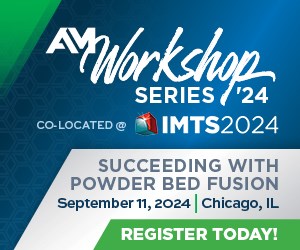Uniformity Labs Develops Ultralow Porosity Stainless Steel Powder for LPBF
The ultralow porosity UniFuse 316L 90-micron stainless steel powder features corrosion resistance, high flexibility and excellent mechanical properties at extreme temperatures.
Bracket 3D printed with Uniformity Labs’ ultra-low porosity UniFuse 316L 90 micron stainless steel powder. Photo Credit: Uniformity Labs
Uniformity Labs’ UniFuse 316L ultralow porosity stainless steel powder is a high-throughput feedstock for additive manufacturing (AM). Is is said the material’s 90-micron, 400-W performance mechanical properties are superior in UTS, YS, elongation and density compared to industry standard lower layer thickness parameter sets.
The company says the material works with its high-performance scanning (HPS) to achieve approximately 3 times faster build time when compared to a competitor’s lower layer thickness scan strategies targeting best-in-class mechanical properties. It is said this throughput improvement is typical for UniFuse 316L builds. Compared to similar layer thickness builds, Uniformity Labs UniFuse 316L and HPS achieve superior mechanical properties and build uniformity across the build platform with significantly increased throughput.
Higher bed and tap densities enable Uniformity powders to deliver improved mechanical properties and consistent performance across the build bed, even at high-speed build rates and thicker layer printing.
316L is an austenitic stainless steel which is well suited for demanding environments and applications, such as parts exposed to marine, pharmaceutical or petrochemical processing, food preparation equipment, medical devices, surgical tooling and consumer products such as jewelry. It is known for corrosion resistance, high flexibility and excellent mechanical properties at extreme temperatures.
“The application of Uniformity 316L 90-micron stainless steel delivers mechanical excellence for our customers who require materials that perform to the highest standard in extreme conditions,” says Adam Hopkins, Uniformity founder and CEO. “Our powders deliver superior mechanical properties, surface finish, printing yield and part reliability, and allow one machine to do the work of several.”
- Read about how Uniformity Labs’ stainless steel powders are said to deliver improved mechanical properties at much higher throughput in laser powder bed fusion (LPBF) additive manufacturing.
- Learn about the AddUp Solutions collaboration with Uniformity Labs to maximize the productivity of Uniformity’s Ti64 Grade 23 titanium alloy using the AddUp FormUp350 laser powder bed fusion (LPBF) printer.
Related Content
-
Additive Manufacturing Is Subtractive, Too: How CNC Machining Integrates With AM (Includes Video)
For Keselowski Advanced Manufacturing, succeeding with laser powder bed fusion as a production process means developing a machine shop that is responsive to, and moves at the pacing of, metal 3D printing.
-
8 Cool Parts From Formnext 2023: The Cool Parts Show #65
New additive manufacturing technologies on display at Formnext were in many cases producing notable end-use components. Here are some of the coolest parts we found at this year’s show.
-
DMG MORI: Build Plate “Pucks” Cut Postprocessing Time by 80%
For spinal implants and other small 3D printed parts made through laser powder bed fusion, separate clampable units resting within the build plate provide for easy transfer to a CNC lathe.












.png;maxWidth=300;quality=90)




